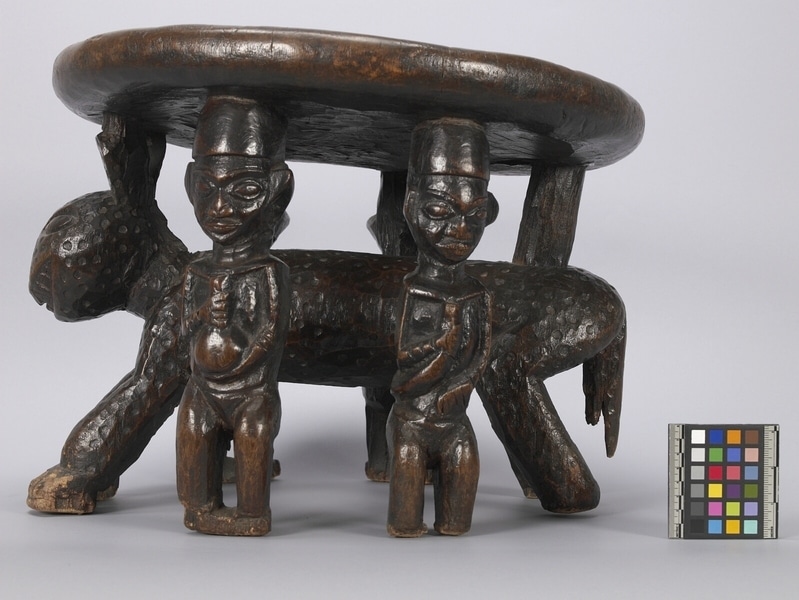Stool Item Number: Ae81 from the MOA: University of British Columbia



Description
Wooden stool, smooth, carved in one piece. Circular, slanted seat; solid tubular edge; supported by four standing human figures with the seat resting on their heads. All with three bracelets incised on their right forearms, supporting jars with their left hands. Jars are joined to bodies and fingers. The other two figures hold in their right hands narrow bag-like objects with long necks curved around sideways. Left hands are pressed to left abdomens. Knees are slightly bent with feet very roughly carved or missing. A spotted standing animal with joined front paws supports underneath the centre of the seat with its back. At the edge a wooden column supports the seat from the hind end and a broken tail hangs down. Solid circular wooden base.
History Of Use
Each ruler had his own stool carved at the beginning of his reign to meet demands of his lineage totem and please his personal taste. It corresponds to a throne in other cultures. Guarded by appointed keepers, given oil baths before festivals, it was occupied only by its owner. At the death of the ruler the stool was stored or disposed of.
Cultural Context
Chief's stool.
Iconographic Meaning
Human figures holding stool are probably women. The leopard has royal qualities and sleeps with one eye open like the king. To help this talent the king receives eyes and hide of every leopard killed in his kingdom (Gebauer and Gebauer).
Item History
- Made in Cameroon
- Collected before 1980
- Owned by E. M. Von Kaldenberg before July 28, 1980
- Received from Museum of Anthropology Shop Volunteers (Funding source) and E. M. Von Kaldenberg (Seller) on July 28, 1980
What
Who
- Culture
- Central African
- Previous Owner
- E. M. Von Kaldenberg
- Received from
- Museum of Anthropology Shop Volunteers (Funding source) and E. M. Von Kaldenberg (Seller)
Where
- Holding Institution
- MOA: University of British Columbia
- Made in
- Cameroon
When
- Collection Date
- before 1980
- Ownership Date
- before July 28, 1980
- Acquisition Date
- on July 28, 1980
Other
- Condition
- good
- Accession Number
- 0640/0043